Henry Gee's Blog, page 13
December 16, 2021
PR
First, I’d like to wish you (both) a happy holiday.
Second, I’d like to share with you my recent experiences promoting my latest book. My agent advised spending a chunk of advance on hiring a PR company for the US market. Which I did. To the tune of $$$$$ a month. For 5 months.
My PR person worked tirelessly – and I mean tirelessly – opening doors for me to write op-ed pieces in print; fixing it so that high-profile print and online media could publish excerpts; getting me on radio shows with large audiences (such as Coast-to-Coast AM, which goes out on 640 US radio stations and reaches 2 million people); organising ‘virtual’ speaking events in the US; and also guesting on podcasts (eight broadcast so far, including Guy Kawasaki’s Remarkable People, with another recorded and two more scheduled).
PR costs a LOT of money, and is a lot of work, too. My PR person had me doing my homework — writing op-ed articles; recording audio segments; organising web resources and generally being more organised than I usually am.
Although some PR is organised by one’s publisher (and some media comes to one directly) a publisher’s in-house PR people have to spread their resources over the authors they think will sell. When you pay extra for your own PR, they tailor a campaign specifically for you, do much more and go deeper.
And the PR trail requires some stamina. Last night, for example, I was recording a program for radio New Zealand, where it was this morning; and this morning I guested live on a US radio talk show, where it was last night, so right now I don’t know if I am coming or going.
Is it worth it? Time will tell. But, these days, there are so many books, and so many authors, that like the Red Queen you have to run as fast as you can just to stay in the same place. Consider – just about every person you see or hear interviewed on radio and TV talk shows is there because they have a book to sell. And unless you’re already a celeb, you have to work much harder to get airtime. These guests are there because they have PR people forever pitching on their behalf to broadcast producers and bookers.
Would I do it again? In a heartbeat.
November 26, 2021
Launch
My latest book A (Very) Short History of Life on Earth has now come out in the US and Canada. Actually, it came out 17 days ago, and it’s available from St Martin’s Press and the proverbial All Good Bookstores, but I haven’t had a moment to carve a word on this until now. It was pipped at the post by versions in Dutch and German; a Spanish edition is now available for preorder; and of course the UK edition, from Picador, has been out for a while.
In thirty years of writing books, this is the first to have made any impact at all. For some years I have subscribed (through Amazon) to a service called NPD Bookscan. This gives me weekly sales of all my print books (so, excluding Kindle and audio) sold either by Amazon or in more than 10,000 US bookstores – some 85% of the bookstores in America. Most weeks I sell one or two. I have never sold more than six in any given week in the past two years. Last week, I sold 536 – this week it’s down to 284. Almost all were of the new book. And this is in the near absence of US print reviews of the book (so far … though the Wall Street Journal did recommend it as a gift book, which can’t have done any harm).
OK, so hardly Harry Potter, I know, but it means a lot to me. My UK publisher tells me that the UK editions has shifted 7,500 copies in all formats and it’s gone into a second printing. They say you have to toil in obscurity for years before you get to be an overnight sensation.
One reason for the visibility is that the book really is available in stores. My previous books have generally be confined to more academic outlets, and this tends to restrict availability. Another is that I have a whole team of people working for me. Not just my marvellous agent, but the publicity people at both US and UK publishers, and, crucially, a PR firm. Through them I’ve got excerpts of the book out in variously visible places, bookings on US radio shows, appearances by Zoom at various events and quite a few podcasts. I’ve been keeping a list here, if you’re interested … but it’s not over yet. There’ll be quite a few more things happening as we slide down towards the festive season. Suffice it to say that rectangular gifts are easiest to wrap. Although I’ve heard that although cylindrical gifts are easier to consume, one shouldn’t let the rectangularity of a gift put you off. Just start nibbling away at the corners.
October 29, 2021
Week
What an ericacious exhausting sackbut amazing week.
It started last Saturday morning when I discovered that I was being followed by the Literary Editor of the Times. Followed, in the sense of Twitter. At least, I don’t think the Literary Editor of the Times really was following me, you know, in person, with a raincoat and binoculars, notwithstanding inasmuch as which the Present Emergency and so on and so forth, though of course he might have been, but if he was, he was very good at it, because I didn’t notice.
Perhaps, though, this was a signal. So alerted, Mrs Gee and I bought a copy of the Times on our regular weekend supermarket trip, just in case we were approached by a stranger who sat down next to us on a park bench and said something innocuous like ‘the tulips bloom early in Vienna this spring’. Actually, it’s only Mrs Gee who ventures into the supermarket. I sit in the car, in the car park. After all, someone has to do the stake-out.
Mrs Gee came out, with the usual groceries — atonal apples, amplified heat, and so on — and a copy of the Times. When we got home we found that my latest book had attracted not just a book review, but the lead book review, noch, and a splendid one it was too. You can read it here.
The effect had a salutary effect on sales. The book had been published in the UK in September. Reviews were sparse but generally good. There was a lovely one in the Literary Review, a magazine for which I have a particular fondness, though its appeal is, as you’d expect, limited to people like me who simply can’t get enough of books. Following that, the Amazon UK ranking crept up to the low thousands. Although my publisher tells me that the algorithms Amazon uses are mysterious, this had to count for something.
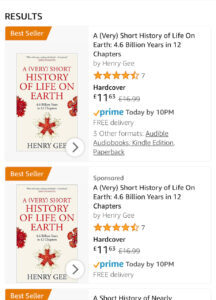 The Times review gave sales a huge boost. Amazon rankings shot up well into the top 200 of all books – up with colouring books, celebrity autobiographies, books for children, and editions of novels by Sally Rooney in Hebrew. At one stage, I was told, the rank was in the 120s, though the highest I saw was 134.
The Times review gave sales a huge boost. Amazon rankings shot up well into the top 200 of all books – up with colouring books, celebrity autobiographies, books for children, and editions of novels by Sally Rooney in Hebrew. At one stage, I was told, the rank was in the 120s, though the highest I saw was 134.
In specific categories, such as ‘palaeontology’ and ‘dinosaurs’, it reached number one and stayed there for some days (see the picture). The hardcover edition was most popular, but the audiobook and kindle versions came up to approached got close.
And, quite unlike any other book I have ever written, it really was available in the canonical All Good Bookshops.
The Amazon rankings subsided over the following days, although very slowly, and as I write it’s still in the top 1000. By the end of the week normal service should be resumed and I shall return to the comforting obscurity to which I have long been accustomed.
People ask me about the paperback. (Well, one person did, take a bow, Mr. G. O. of Norfolk). There is what’s known as a ‘trade’ paperback, available from foreign markets that are less receptive to hardbacks. The UK ‘mass market’ paperback should be out in autumn 2022.
Meanwhile, editions are already out in German and Dutch, and on 9 November it’ll be published in the US & Canada.
In preparation I’ve been a guest on a lot of podcasts that’ll be broadcast nearer the time (I already have a podcast series of my own that you can hear now). I have a feeling that the hoopla has hardly begun.
October 3, 2021
Office
Small spaces at home, hitherto neglected nooks and crannies, have begun to assume a far greater importance in our lives than they once did. These are those closets, spare bedrooms, cupboards under the stairs, corners of bedrooms, edges of dining tables or breakfast bars and so on where many people now do their work, when once they would commute to somewhere perhaps more suitably equipped.
I’m lucky in that even before the Present Unpleasantness I have worked at home for most of the time. When the Gees first moved to Cromer, in 2006, I really did work in a cupboard under the stairs, though back then I commuted more. In 2011 we remodeled the house, adding a kitchen diner at the back, so I moved into (most of) the old galley kitchen. And that’s been my office/ studio/ man cave/ dojo/ fun palace/ library ever since. This is what it looked like a couple of weeks ago.
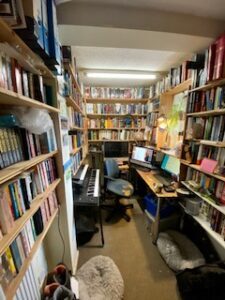
I did most of the working (and music-making) at the far end. Although it’s a long narrow room, it seems much longer because I used a wide-angle lens to get it all in. In actual fact the total floor area is less than six square metres.
After working hard all summer at the Submerged Log Company, as well as finishing my latest book — and recording the audiobook version thereof — I felt that it was high time for a refurb. I spend quite a lot of time in the home office, whether for the day job; writing on my own account; writing and recording music; or just relaxing; and after ten years of occupation it had begun to look a bit scruffy. There were some ugly stains on the ceiling (a result of minor flooding from the bathroom above), and I realized that behind the bookshelves there was still some raw plaster and even a few holes from when the room had once been a kitchen. Even the wire that had powered the cooker still protruded from the wall. So I decided to take some time off to gut the place.

It took four days — FOUR DAYS — to remove the hundreds of books, sound equipment, sundry gewgaws, bibelots, unicycles, girrafes, and other stuff. Luckily we have a capacious garden summerhouse.
It took another three days to prep the place for repainting. I pulled up the scuzzy floor tiles. I filled up all the holes. I vacuumed. I threw out trash. I vacuumed again. I sugar-soaped the walls. I did more vacuuming. The dust, my dears, the DUST.
The time came at last to apply, you know, actual paint.
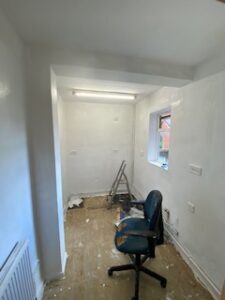 And here it is after the first coat of Homebase Pure Brilliant White. One thing I discovered while doing this job is that, like Michelangelo, I don’t like painting ceilings very much. A friend suggested I send the bill to the Pope. So His Holiness might soon be getting a receipt for a large tub of the aforementioned Homebase Pure Brilliant White. and a paint roller.
And here it is after the first coat of Homebase Pure Brilliant White. One thing I discovered while doing this job is that, like Michelangelo, I don’t like painting ceilings very much. A friend suggested I send the bill to the Pope. So His Holiness might soon be getting a receipt for a large tub of the aforementioned Homebase Pure Brilliant White. and a paint roller.
After two coats — and two days — Offspring 2, who has far greater attention to detail than I, came in to touch up the bits I’d missed.
 Then the time came to install a large shelf with legs, which has pretensions to being a desk.
Then the time came to install a large shelf with legs, which has pretensions to being a desk.
The next task was to attach fourteen vertical runners to the walls, for the shelves. This meant drilling a lot of holes, with a power drill. Another thing I discovered while doing this job was that I am not fond of power tools, especially in a confined space. The NOISE. You might ask why I didn’t use the same holes as before. Well, that would have been too easy. Besides, I wanted some of the shelves in different places.
This took two days. Or, rather, four hours, spread over two days. I could only take so much of the noise (and the vibration), and I wanted to spare the neighbours. After that I could put up the shelves. Quietly.
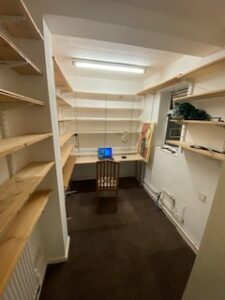 After a lot more vacuuming it was time to install new carpet tiles. Last time I did this I glued them down with special tile adhesive, and after some time in this confined space I felt that I was being cheered enthusiastically on by Harvey the Giant Pink Octopus and his All-Star Orchestra featuring the Crustacean Choristers, with, towards the end, Agama Gekko and the Iguana Brass. This time the tiles were thicker and backed with bitumen, so could simply be laid flat on the ex-council lino, without adhesive of any kind, not even hallucinogenic, although I still had to cut a few to fit. This only took an evening, but took longer than it might have done because the dog felt she had to come and ‘help’. This meant that short bursts with a sharp knife and straight-edge were interspersed with longer intervals of rolling around on the floor admiring whichever soft toy was the dog’s favorite that day.
After a lot more vacuuming it was time to install new carpet tiles. Last time I did this I glued them down with special tile adhesive, and after some time in this confined space I felt that I was being cheered enthusiastically on by Harvey the Giant Pink Octopus and his All-Star Orchestra featuring the Crustacean Choristers, with, towards the end, Agama Gekko and the Iguana Brass. This time the tiles were thicker and backed with bitumen, so could simply be laid flat on the ex-council lino, without adhesive of any kind, not even hallucinogenic, although I still had to cut a few to fit. This only took an evening, but took longer than it might have done because the dog felt she had to come and ‘help’. This meant that short bursts with a sharp knife and straight-edge were interspersed with longer intervals of rolling around on the floor admiring whichever soft toy was the dog’s favorite that day.
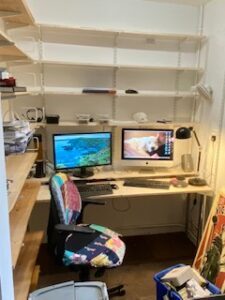 Only then could I install the computers and associated electrical equipment – much easier to do before the books come back.
Only then could I install the computers and associated electrical equipment – much easier to do before the books come back.
In the meantime, comments had been made on Social Media about the scruffiness of my chair. Well, I have had that chair for at least a quarter of a century. I have written many books while seated in that chair, notwithstanding inasmuch as which processed many thousands of submerged logs. That chair was good enough for me. But Mrs Gee very kindly re-covered the chair with the fabric from some very colorful but worn-out trousers she once wore, giving the chair a fetching and funky new appearance.
 And now, the books. The refurbishment was an excellent opportunity to have a cull. I really don’t like getting rid of books, but as I am fast coming up to rapidly approaching my seventh decade, I made one of two executive decisions – that if I have read a book and am unlikely to read it again, then I should donate it to a charity shop so someone else can have a go. This picture shows a huge pile of crates filled with books destined for our favourite secondhand bookstore, which is at Blickling Hall, a local National Trust property. Almost all of these books are from the Office, though Mrs Gee and I have been thinning out drifts of books that have accumulated elsewhere chez Gee. Working at a publishing company, as I do, I tend to accrete books without knowing it. I also had a large pile of generic thrillers, acquired in two episodes. The first was when a elderly neighbour was in hospital for some weeks trying to shake off pneumonia. He was a voracious reader, and before each visit I’d trawl charity shops for airport-lounge-style thrillers and whodunits. Sadly his pneumonia won in the end, and after his death, his widow returned the books. The second episode was when I broke an ankle in August 2018 and was confined to bed for a couple of months, and neighbours and friends kindly gave me lots of entertaining reading. Much of it now read – the rest, I’m unlikely to – so off they go.
And now, the books. The refurbishment was an excellent opportunity to have a cull. I really don’t like getting rid of books, but as I am fast coming up to rapidly approaching my seventh decade, I made one of two executive decisions – that if I have read a book and am unlikely to read it again, then I should donate it to a charity shop so someone else can have a go. This picture shows a huge pile of crates filled with books destined for our favourite secondhand bookstore, which is at Blickling Hall, a local National Trust property. Almost all of these books are from the Office, though Mrs Gee and I have been thinning out drifts of books that have accumulated elsewhere chez Gee. Working at a publishing company, as I do, I tend to accrete books without knowing it. I also had a large pile of generic thrillers, acquired in two episodes. The first was when a elderly neighbour was in hospital for some weeks trying to shake off pneumonia. He was a voracious reader, and before each visit I’d trawl charity shops for airport-lounge-style thrillers and whodunits. Sadly his pneumonia won in the end, and after his death, his widow returned the books. The second episode was when I broke an ankle in August 2018 and was confined to bed for a couple of months, and neighbours and friends kindly gave me lots of entertaining reading. Much of it now read – the rest, I’m unlikely to – so off they go.
 The remaining books re-shelved, the last task was to reinstall Flabbey Road, my home studio. Which I did. The second executive decision I made was that my days of live playing are over. I really don’t much like wiring things up, taking all the wires out again, schlepping huge boxes around in the middle of the night, wiring them up again, playing for a few bored punters wildly enthusiastic crowds, and doing it all in reverse when I could be comfily at home watching Strictly with the family. Besides, lockdown has taught me that I can record whole albums at home, as well as audiobooks.
The remaining books re-shelved, the last task was to reinstall Flabbey Road, my home studio. Which I did. The second executive decision I made was that my days of live playing are over. I really don’t much like wiring things up, taking all the wires out again, schlepping huge boxes around in the middle of the night, wiring them up again, playing for a few bored punters wildly enthusiastic crowds, and doing it all in reverse when I could be comfily at home watching Strictly with the family. Besides, lockdown has taught me that I can record whole albums at home, as well as audiobooks.
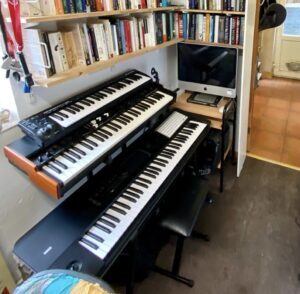 Here is what it looks like from the other end.
Here is what it looks like from the other end.
And that’s it. It took the full fourteen days, or even a fortnight. And it was exhausting. Some days all I could do of an evening was flake out in front of the TV while I felt the blood pounding in my arms and legs. All that moving of books and equipment, all that stretching and bending, toting barges, lifting bales, while wielding a paint roller/ vacuum cleaner/ carpet knife/ etcetera.
But I’m very glad it’s done. I must say I couldn’t have done it without the support of the family, who had to tolerate the mess and dust and fumes and general chaos. Should be good for at least another ten years. Next stop – tidy the toolshed.
September 16, 2021
Spayed
It’s been a funny old day. It started in a celebratory mood as my book finally got to be published in the UK. And also, in Dutch, in Holland. I have been basking in congratulatory messages, which has been lovely, and if you want to know what the fuss is all about, you may visit the book’s very own website, which is here.
But the day was also deviant in its routine as I had to get my faithful dog Lulu to the vet to be spayed. This is an appointment of long standing, and calculated from the end of her last being in season. She is now back from having been spayed, surprisingly perky withal, and modelling a very smart babygro. But I’ll be nursing her this evening.
And it also happens to be Yom Kippur, a day in which publishing books and nursing spayed dogs should really be very far from one’s mind. Real life, eh?
August 24, 2021
Failure
I’ve seen a lot of emissions on social media lately consoling those who might not have achieved the grades they wanted in order to go to their preferred job or institute of higher learning. Therefore I thought I should contribute to the now-customary general outpouring and effusion of platitudes by people saying that there are more things in life than exams, that things happen for a reason, and so on, and so forth, notwithstanding inasmuch as which I invite you to consider, therefore, my so-far stellar career…
— I failed my Eleven-Plus.
— I failed my Common Entrance for public school. I did however make the subs’ bench and was asked for an interview. I took my fossil collection to show the headmaster and didn’t let him get a word in edgeways. I got in.
— I failed A-level maths. That is, I got an ‘E’, which wasn’t good enough. I had to re-take a year. In the end I got a ‘C’, which was honestly the best I could manage, and enough (just) to get into University.
— I failed my entrance exam to be an undergraduate at Cambridge. ‘Don’t worry’, my Mum said, ‘you’ll get there as a graduate student’. Which I did. I did my undergraduate degree at Leeds, which I loved, and was much more fun than Cambridge would have been. I got a 1st and went to Cambridge to do a PhD.
— I failed my PhD viva. They offered me an MSc as a consolation prize. No, I said, I’d rewrite my thesis. Which I did. I got my PhD.
— While I was writing up (the second time) I was invited to join the staff of the Submerged Log Company. That was more than 33 years ago. So despite the three six five failures listed, I haven’t done too badly. For more advice on the sometimes circuitous route one can take to career success, I refer you to this recent eructation from my colleague Professor Rohn.
August 8, 2021
August
August is a funny month. The nights start to draw in rather quickly as summer draws to a close with what seems like unseemly haste. Keen, fitful gusts of autumn are followed by a rumble of thunder.
I am in the garden, pulling up the last of the carrots (yummy) and the garlic (will weave into a plait and hang up somewhere); harvesting courgettes that have grown as large as zeppelins under what seems to be a jungle of tropical leaves; and seeing if we have any tomatoes yet (everything this year is late, late. late). I’m digging over the plot and will be sowing spinach and kale for overwintering; pricking out tiny baby leeks; and trying again with lettuces (a failure this year – usually we are awash with them).
When the sun shines it’s brassy and hot but somehow melancholic, as if it’s having its last hurrah. There is a kind of torpor.
And some people do not seem to have enough to do.
Twice, in as many days, I have received somewhat impatient emails from friends (two different ones), complaining why a third person (again, different in each case), with whom I am acquainted but over whose actions I have no responsibility, hasn’t responded promptly to some inquiry or other. One of these was actually complaining to said third person about the inaction of a fourth person of whose existence I had not previously heard.
I respond that, in August, that fag-end of blowsy summer, one must be patient. People are probably taking a well-deserved vacation. Or they might be beset with travails of which one knows nothing. Oh, yes, and COVID, that contagion/ government plot/ excuse for inaction (delete as applicable) which, whatever else one might say about its origins and career, seems to make everything take three times as long as it usually does, and that’s quite long enough.
In any case, what do people expect me to do about it? I have not the judgment of Solomon, nor, thankfully, the responsibility, and although I may Walk the Walk and Talk the Talk, reports of my omnipotence are greatly exaggerated.
Sometimes it feels as if the whole world wants a piece of me. But, really, I’m just as lost as everyone else.
July 25, 2021
Ultramarine
One or two of you might have read By The Sea, my Gothick Bodice Ripper with Detectives, which was originally serialized by my Occam’s Typewriter Compadre Jenny Rohn on her LabLit website, but now published in book form and available on all good e-book platforms, and even as a paperback. One of the readers was my friend Mr J. W.-V., a fellow Norfolk resident, musician and newsroom journalist. Like me, Mr. J. W.-V. is a Driven Man, who simply must fill every minute with sixty seconds’ distance run, so in addition to doing — oooh — all sorts of things, he has decided to learn how to write an adapted screenplay, and, blow me down, he chose By The Sea as a text to adapt, egged on by Mrs L. W.-V., who had first devoured enjoyed the book.
Mr J. W.-V. sent me the completed treatment, adapted for some future televisual emission — full of apology that he had had to condense a somewhat ruminative, detailed story full of internal monologue into a zippy screenplay. I have to say he’s done a terrific job — and I can say publicly that no apology is necessary.
Here’s why.
Many years ago when I was a graduate student I found myself engaged in discussion with a literature major who told me what, then, to me, seemed an outrageous notion. That is, although an author might put their name on a work, it doesn’t really belong to them. Over the years I have come to believe she was right. It’s a view that authors as diverse as Tolkien and Borges certainly would have acknowledged.
Tolkien wrote that authors should hold on to their works but lightly, as, once they are in the world, people might well seek to embellish them in other means or media. Indeed, it is the failure of a jealous creator to allow others to share in their glory that is the driver of the Silmarillion, the root tale of his legendarium, and the debatable relationship between creators and their works is a theme that runs throughout his stories. When applied to literature, then, it follows then that if other people bring their thoughts to bear, even changing essential parts of the story, it is their right to do so. One might not agree with such changes — but in publishing a work at all such that others might read it, one has no right to complain. Borges, for his part, riffed on the idea of influence-spotting in his characteristically playful essay Kafka And His Precursors. So, if all this was good enough for Tolkien and Borges, it’s good enough for me.
For one thing, authors draw material out of their influences; things they have read; ideas that have in turn been influenced and shaped by myriad other influences, or just out of the air. Nothing is ever created that’s entirely original or new. When asked about the influences for his remarkable Ents – those strange humanoid mobile trees – Tolkien admitted that he didn’t know whence they had sprung, except, perhaps, from an array of influences that might have composted and mixed together in his mind.
Second, a book is no more than an pile of inert scratchings until and unless someone else reads it, and their picture of it might be very different from that in the author’s mind, bringing to it a raft of ideas and associations which are all their own, and nothing to do with the author. A book is an ongoing, ever-changing, protean conversation between author and reader.
The consequence is that once a book is let out into the world, the author really has no license to criticize what anyone else does with it, especially in another medium. So, if Mr J.-W.-V.’s screenplay gets taken up and actually realized, I’ll be the first on the sofa with the popcorn.
July 2, 2021
Nautilus
I really can’t believe it.
I’ve been writing books for thirty years, but have never seen the anticipation that’s buzzing around my fifthforthcoming tome, A (Very) Short History of Life on Earth.
When a book of mine is published, it’s usual for me to receive translation offers in one or two languages, but only after it’s been out for some time. This time, it’s racked up twelve translation-rights sales, even before it’s out in English. Dutch and German editions are in preparation – editions are projected in simplified Chinese, Greek, Italian, Japanese, Korean, Polish, Portuguese, Romanian, Russian and Spanish.
Such is the buzz that I have engaged the services of a PR company to capitalize on the interest in the US and Canada, to promote the edition from St Martin’s Press, published on 2 November. Picador, which publishes the UK+Commonwealth edition on 16 September, is doing the publicity in-house.
Not that I can’t get away without doing some initial spadework – the PR people don’t know me from any other Joe, so I have been busy updating my various social media profiles, constructing this useful website and facebook page.
But what I am looking forward to most is recording the audiobook. As far as I can judge from rankings on Amazon (ever a delphic measure), pre-orders for the book have been stronger for this format than for the print or electronic versions.
The audiobook people originally wanted me to come into a studio to do the recording. However, thanks to the proficiency I’ve gained by recording music during lockdown in Flabbey Road, my home studio, they are letting me do it all by myself, on my own, unaccompanied, and, what’s more, tout seul.
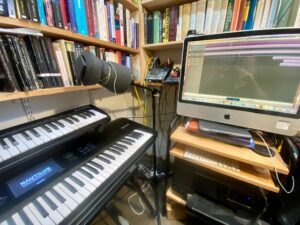
Inside Flabbey Road. Recently. Note home-made pop-shield on microphone.
Notwithstanding inasmuch as which, I can get to add some music, so I have been thinking up some themes.
To help me with this I have brought in the heavy brigade in the form of a Korg Nautilus, the kind of keyboard that composers use to create film soundtracks. The cinematic hugeness should, I hope, augment the book rather than swamp it (though I will have a producer to curb my worst excesses).
One of the primary sauces tzores sources of inspiration for the book was Life On Earth, a documentary series by David Attenborough from the 1970s. This transfixed the teenage Gee. Even though everyone remembers the (for the time) astonishing visuals, what captivated me just as much, at the time, was the soundtrack. I can’t remember much about it now, except that there was a lone horn figure at the end of the title music that it was both haunting and majestic. While I was writing A (Very) Short History, music was very much on my mind, so I welcome the chance to add some of my own to my narration. It should alleviate the boring drone of my voice, at least.
June 11, 2021
Pride
Here’s a story about Pride, and the best party I ever attended.
It started in 2017, when the Gees had a wonderful family holiday in Northumbria. The fact that I could never seem to find Hadrian’s Wall, no matter how manically I drove along country lanes trying to find it, became a family joke. I had somehow expected some imposing structure like the Great Wall of China when, in fact, much of it has disappeared and the parts that survive are rather modest.
The following year Mrs Gee booked me and Offspring#1 (my regular hiking partner) into an establishment called the Hadrian Hotel in a village called Wall. ‘If you can’t find Hadrian’s Wall from the Hadrian Hotel in a village called Wall,’ she said, ‘then you are beyond hope’. So Offspring#1 and I traveled to the village called Wall, stayed in the Hadrian Hotel, and, after some hiking around, discovered Hadrian’s Wall to our mutual satisfaction. After that we traveled north, to Stirling, so we could visit Doune Castle, location for many of the castle shots in our favourite film, Monty Python and the Holy Grail. After much French Taunting, we drove south for the final leg of our three-centre holiday — Nottingham, where Offspring#1 is a medical student and a rising star in the LBGTQ+ community, and was due to do a cabaret turn in the DirtyFilthySexy Pride After-Party.
So there we were, and while Offspring#1 got trogged up, I nursed a pint in the bar and read a book. I am not a party animal. Having scored fairly highly on Simon Baron Cohen’s Asperg-O-Meter, I am not especially gregarious. I can never really see the point of parties, and, if I ever go to one, I’ll be in the kitchen, or somewhere on the fringes, or even not there at all, having made my excuses and left.
But then, something happened. The records they were playing in the next room weren’t thumpity-thump club beats, but disco classics from my childhood. I finished my pint and migrated to the disco, taking up a station in a dark corner on the wall, away from the flashing lights.
My feet started to move.
I got up.
I started to … dance.
So did everyone else. The go-go dancers on the stage were sexy. The harness-clad leather boys that followed were … interesting. I even managed something I have never done at a party, ever — I pulled. (He wasn’t my type). The cabaret was a lot of fun (and Offspring#1’s turn was fantastic, but I would say that, as I’m biased). After the cabaret I continued to dance. I was still dancing at 1 a.m., although more slowly, because I was getting tired, and, by then, the dance floor had become rather sticky. I didn’t know this then, but Offspring#1, in the Green Room, was trying to find me and asked their drag-act friends where I might be.
‘What’s he look like?’
‘Fifty-something. Beardy.’
‘Oh yes – he’s still on the dance floor.’
Offspring#1 sent out a search party. Thus it was that I was approached by a drag queen, at least six-foot-six foot tall (must have been the heels) and resplendent in purple taffeta and glitter, who asked me in stentorian tones, ‘Are you Offspring#1’s Mum?’
I said that I was, and remarked how much I was enjoying the party, and how I didn’t usually go in for such things, especially not the part about boogying until the small hours, as I wasn’t as young as I looked. ‘Yes, we all have that problem’, said my interlocutrix, who wafted off Offspring#1-wards.
How did a heterosexual and blokey and habitually non-partygoing person (that’s me) enjoy this party so much?
It didn’t take me long to work it out.
The reason was this – that everyone came not as the persona they are usually required to adopt to fit into everyday society, but as the persona they felt themselves to be, whether they were in street clothes or the most elaborate gender-bending confections imaginable. Everyone was, therefore, relaxed. Each person was there to enjoy themselves and have fun with other similarly-minded people, not to fulfil any prior expectations of what they ought to be, or do. As Nietzsche once wrote, to be is to do. And as Sinatra added, do-be-do-be-do. It didn’t matter if you were straight, L, G, B, T, Q, or even +. The important thing was to be there.
As someone who scores highly on the Baron Cohen Asperg-O-Meter, what I value in people is honesty. That’s why I loved being an undergraduate in Leeds, in Yorkshire, where everyone calls a spade a vertically operated digging implement, but didn’t really get on at Cambridge, where many people seem to have a ‘side’. The thing about the DirtyFilthySexy party was its honesty. It may seem highly contrived if, say, a marketing manager called Kevin comes out at weekends as a vampish dominatrix called Lola – but it is not contrived at all if Lola is the persona in which that person feels more themselves, more honest, more real.
I was struck by a sentence in a book about the style known as ‘camp’. (The book was called Camp, but I can’t locate it right now). The essence of camp, said this book, was a kind of knowingness — that even though we live in a fallen and damaged world, we should strive for innocence.



